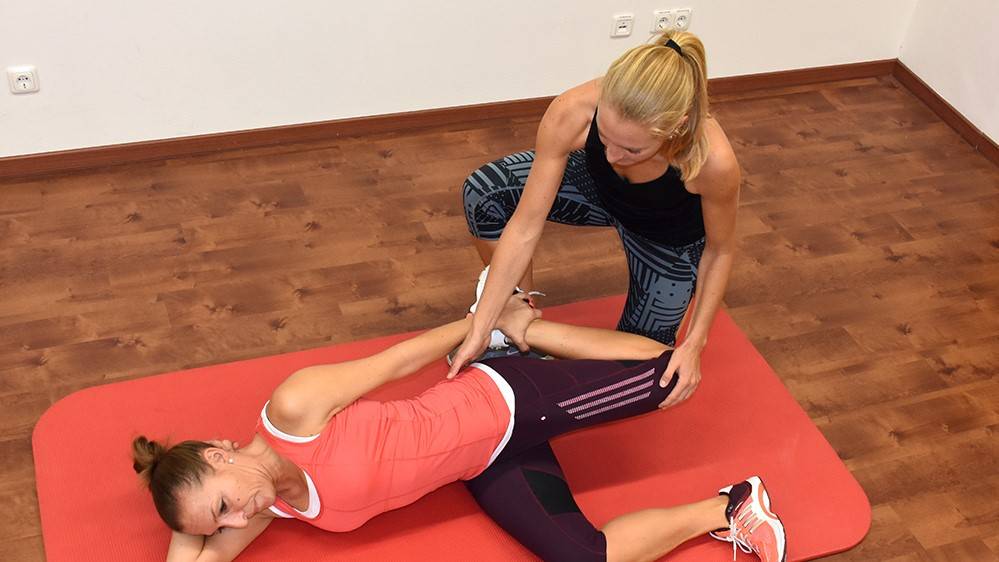Läufer werden nicht selten von Knieschmerzen geplagt. Dabei können Beschwerden an ganz unterschiedlichen Stellen des Kniegelenkes auftreten. Eine der möglichen Ursachen für den Schmerz auf der Innenseite des Knies (medial) kann eine muskuläre Dysbalance der Fuß- und Beinmuskulatur sein. Die Experten Heidi Sessner und Silja Pfeiffer wissen Abhilfe.
Bevor das Training beginnt, solltest du dich wie immer vorsichtig aufwärmen. Beginne die Einheit mit der Fascienrolle und bearbeite zunächst die Oberschenkelvorderseite. Starte in Bauchlage. Rolle längs zum Muskelverlauf von der Kniescheibe bis zur Hüfte auf und ab.
Weiter geht es mit der seitlichen Oberschenkelmuskulatur (Traktus): Gehe in Seitlage, lege dich mit dem Oberschenkel auf die Rolle. Stelle das obere Bein vor dem Körper ab und rolle längs auf und ab.
Weiter geht es mit dem MovementPrep. Ziel ist die Mobilisation von Knie- und Hüftgelenk, sowie Dehnung der Beinmuskulatur.
Gehe in den Einbeinstand. Umgreife das freie Bein mit beiden Händen unter dem Knie, ziehe es mit beiden Händen Richtung Brustkorb und richte dabei den Oberkörper auf.
Stabiles Fußgewölbe als Schlüssel zur Schmerzfreiheit
Das A und O für eine optimale Beinachse beim Laufen ist ein stabiles Fußgewölbe. Die physiologische Beinachse ist eine gerade Linie vom Sprunggelenk über das Knie bis zur Hüfte. Ursache für den medialen Knieschmerz, also dem Schmerz auf der Innenseite des Knies, ist häufig ein zu schwaches Längsgewölbe des Fußes und eine Insuffizienz des Vastus medialis, dem inneren Anteil des vorderen Oberschenkelmuskels.
Ein zu schwaches Fußgewölbe kann in der Folge zu einer Abweichung der Beinachse führen (X-Bein / O-Bein). Bei einem zu schwachen Längsgewölbe des Fußes beispielsweise kippt der Fuß nach Innen und hat eine X-Beinstellung des Knies zur Folge.
Der Vastus medialis sorgt dafür, dass das Knie in der Standbeinphase nicht nach Innen knickt. Ist dieser zu schwach, weicht das Knie nach Innen aus und die Strukturen auf der Innenseite des Kniegelenkes werden überlastet. Schmerzen im Knie können die Folge sein.
Erste Übung: Aufrichtung / Stabilisation des Fußgewölbes
Fußgewölbe aufbauen: Starte im Sitzen und achte auf die Belastung dieser drei Punkte: Fersenaußenseite, Kleinzehenballen, Großzehenballen
5-10 Mal, 8-10 Sekunden halten
Zweite Übung: Beinachsentraining mit stabilem Fußgewölbe
Starte im Sitzen und achte darauf, wie in der vorherigen Übung, Spannung im Fußgewölbe stabil aufzubauen. Stehe nun langsam auf und setze dich dann wieder hin. Achtung: halte die Spannung im Fußgewölbe! Achte auch auf ein stabiles Knie: Es sollte keine Ausweichbewegung nach innen oder außen auftreten!
Steigerungsvarianten:
- Kniebeuge ohne Stuhl: Achte darauf, die Bewegung langsam und sauber auszuführen. Führe die Kniebeuge nur so tief aus, solange du die Spannung im Fußgewölbe stabil halten kannst
- Kontrolle des stabilen Fußgewölbes mit Theraband: Klemme ein Ende des Therabandes unter die Fersenaußenseite, das andere unter den großen Zeh und halte die Spannung. Schnalzt das Band nach oben weg, wurde das Fußgewölbe nicht korrekt belastet.
Dritte Übung: Kräftigung Vastus Medialis mit Theraband
Befestige das Theraband unten befestigen (z.B. mit Knoten unter der Tür). Stelle dich seitlich neben das Band. Das zu trainierende Bein steht außen. Fasse mit beiden Händen das Theraband. Gehe in den Ausfallschritt: Das vordere Knie soll im rechten Winkel gebeugt sein und senkrecht über dem Sprunggelenk stehen. Nun das Theraband von innen-unten diagonal nach außen-oben ziehen. Achtung: Das vordere Knie bleibt stabil und weicht weder nach Innen oder Außen aus.
3 mal 25-20 Wiederholung
Cool Down:
- Stretching der vorderen Oberschenkelmuskultur in Seitlage oder im Stand
- Mobilisation der Plantarfascie (Fußsohle) mit dem Fascienball/ Tennisball




















